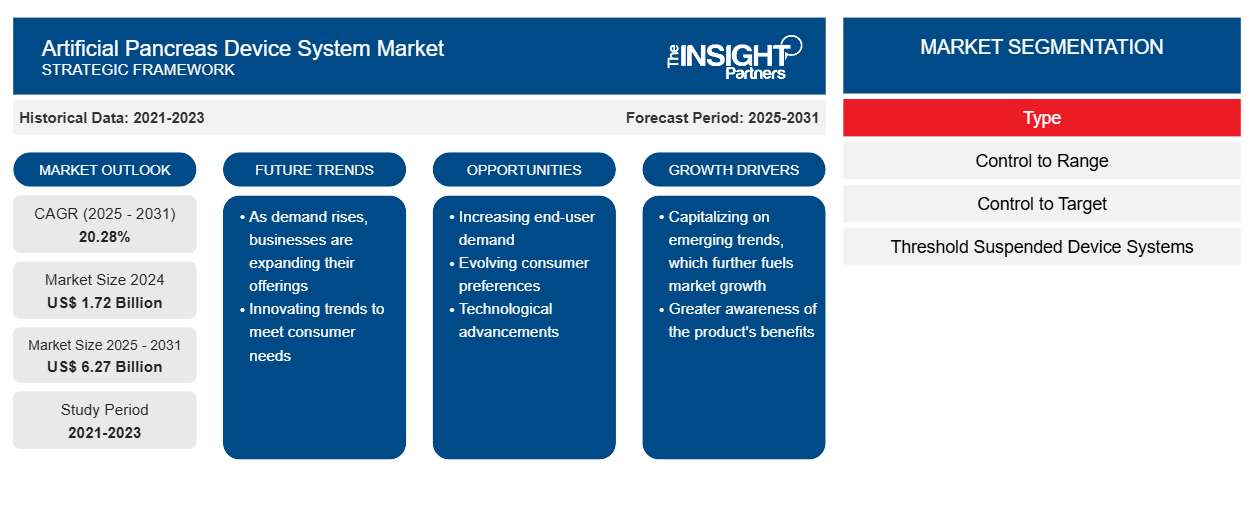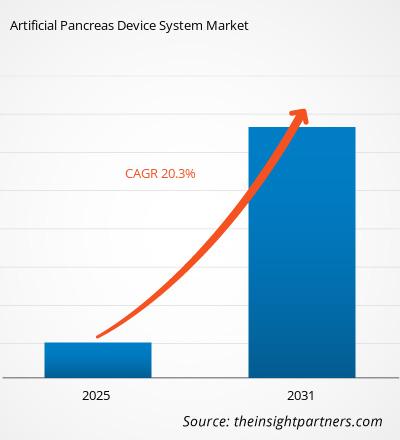Der Markt für künstliche Bauchspeicheldrüsensysteme soll von 1.190,23 Millionen US-Dollar im Jahr 2022 auf 3.585,75 Millionen US-Dollar im Jahr 2031 anwachsen; von 2022 bis 2031 wird mit einer durchschnittlichen jährlichen Wachstumsrate von 20,28 % gerechnet.
Künstliche Bauchspeicheldrüsensysteme imitieren die Glukoseregulierungsfunktion der gesunden Bauchspeicheldrüse. Das Gerät überwacht nicht nur den Blutzuckerspiegel, sondern passt auch automatisch die Insulinausschüttung an, um den Blutzuckerspiegel zu senken. So verringert sich die Häufigkeit von Unterzuckerungen ohne oder mit weniger Zutun des Patienten. Laut der US-amerikanischen Gesundheitsbehörde FDA ist der Einsatz einer künstlichen Bauchspeicheldrüse im Vergleich zur Standardbehandlung mit einer besseren Blutzuckerkontrolle bei Typ-1-Diabetes verbunden.
Der Markt für künstliche Pankreasgeräte ist nach Typ und geografischer Lage segmentiert. Geografisch unterteilt sich der Markt grob in Nordamerika, Europa, den Asien-Pazifik-Raum, den Nahen Osten und Afrika sowie Süd- und Mittelamerika. Der Bericht bietet Einblicke und detaillierte Marktanalysen mit Schwerpunkt auf Markttrends, technologischem Fortschritt und Marktdynamik sowie einer Analyse der Wettbewerbslandschaft der weltweit führenden Marktteilnehmer.
Sie erhalten kostenlos Anpassungen an jedem Bericht, einschließlich Teilen dieses Berichts oder einer Analyse auf Länderebene, eines Excel-Datenpakets sowie tolle Angebote und Rabatte für Start-ups und Universitäten.
Markt für künstliche Pankreasgerätesysteme: Strategische Einblicke

-
Holen Sie sich die wichtigsten Markttrends aus diesem Bericht.Dieses KOSTENLOSE Beispiel umfasst Datenanalysen, die von Markttrends bis hin zu Schätzungen und Prognosen reichen.
Markteinblicke
Steigende Diabetes-Prävalenz stärkt den Markt für künstliche Bauchspeicheldrüsensysteme
Diabetes ist eine lebensbedrohliche chronische Erkrankung, für die es keine spezielle Heilung gibt. Die Krankheit wird hauptsächlich durch die Unfähigkeit des Körpers verursacht, das Hormon Insulin zu produzieren oder effektiv zu nutzen. Sie ist eine der größten globalen Gesundheitskrisen des 21. Jahrhunderts. Diabetes verhindert, dass der Körper den Blutzuckerspiegel ausreichend reguliert. Es gibt zwei Arten von Diabetes: Diabetes Typ I (auch bekannt als Diabetes insipidus) und Diabetes Typ II (auch Diabetes mellitus genannt). Übergewicht, Bewegungsmangel und ungesunde Essgewohnheiten sind die Hauptrisikofaktoren, die mit der rapide steigenden Zahl von Diabetikern in Verbindung gebracht werden.
Laut der International Diabetes Federation (IDF) wird die Zahl der Diabetiker in Nordamerika voraussichtlich von ca. 46 Millionen im Jahr 2017 auf ca. 62 Millionen im Jahr 2045 steigen; die Krankheitsprävalenz wird im Prognosezeitraum voraussichtlich um ca. 35 % zunehmen. Laut der American Diabetes Association litten im Jahr 2017 ca. 30,3 Millionen Menschen, d. h. bis zu 9,4 % der US-Bevölkerung, an Diabetes; davon litten 1,25 Millionen Kinder an Diabetes Typ I. Auch die National Institutes of Health geben an, dass die Fälle von Diabetes Typ I weltweit rapide zunehmen und eine beträchtliche Anzahl von Kindern und Jugendlichen betrifft. Der gleichen Quelle zufolge litten im Jahr 2017 in Südostasien ca. 84 Millionen Menschen an Diabetes. Von diesen Patienten leiden 149.300 Kinder an Diabetes Typ I und benötigen täglich Insulinspritzen. Typ-2-Diabetes ist die häufigste Form von Diabetes und hat parallel zu kulturellen und gesellschaftlichen Veränderungen zugenommen. In Ländern mit hohem Einkommen leiden bis zu 91 % der erwachsenen Diabetiker an Typ-2-Diabetes. Laut IDF lebten 2017 weltweit rund 425 Millionen Menschen mit Diabetes, und bis 2045 wird diese Zahl voraussichtlich auf 629 Millionen ansteigen.
Diabetes aller Art kann zu verschiedenen Komplikationen in vielen Körperregionen führen und das Risiko eines vorzeitigen Todes erhöhen. Herzinfarkt, Schlaganfall, Nierenversagen, Beinamputation, Sehverlust und Nervenschäden sind die häufigsten Komplikationen dieser Krankheit. Patienten mit Diabetes benötigen regelmäßige Überwachung und externe Insulingabe.
Typ-Einblicke
Je nach Typ ist der Markt für künstliche Pankreasgerätesysteme in Systeme mit Bereichssteuerung, mit Zielsteuerung und mit Schwellenwert-Aussetzung unterteilt. Im Jahr 2022 hatte das Segment der Gerätesysteme mit Schwellenwert-Aussetzung den größten Marktanteil. Es wird außerdem erwartet, dass dieses Segment zwischen 2022 und 2031 die höchste durchschnittliche jährliche Wachstumsrate (CAGR) verzeichnet. Bei Geräten mit Schwellenwert-Aussetzung, auch Systeme mit niedriger Glukose-Aussetzung genannt, wird die Insulinabgabe für eine festgelegte Zeit ausgesetzt, wenn 2 Glukosewerte unter einen bestimmten niedrigen Wert fallen, was auf Hypoglykämie hinweist. Ein Gerät mit Schwellenwert-Aussetzung hilft, den Abfall des Blutzuckerspiegels umzukehren. Bei Geräten mit Schwellenwert-Aussetzung, auch Systeme mit niedriger Glukose-Aussetzung genannt, wird die Insulinabgabe für eine festgelegte Zeit ausgesetzt, wenn 2 Glukosewerte unter einen bestimmten niedrigen Wert fallen. Geräte mit Schwellenwert-Aussetzung können auf ein niedriges Blutzuckerereignis (Hypoglykämie) nicht reagieren.
Produkteinführungen sowie Fusionen und Übernahmen sind die am häufigsten genutzten Strategien von Unternehmen auf dem globalen Markt für künstliche Pankreasgeräte. Nachfolgend sind einige der wichtigsten Produktentwicklungen der letzten Zeit aufgeführt:
- Im Juni 2021 erhielt Medtronic die CE-Kennzeichnung für das MiniMed 780G-System zur Behandlung von Typ-1-Diabetes-Patienten im Alter von 7 bis 80 Jahren.
- Im April 2022 arbeitete Abbott mit Ypsomed und CamDiab zusammen, um ein künstliches Pankreassystem nach Europa zu bringen.
- Im Januar 2021 brachte Medtronic sein MiniMed 780G-System in Großbritannien auf den Markt. Es handelt sich um ein fortschrittliches hybrides Insulinabgabesystem mit geschlossenem Kreislauf, das zur Behandlung von Typ-1-Diabetes bei Menschen im Alter von 7 bis 80 Jahren eingesetzt wird.
Markt für künstliche Pankreasgerätesysteme – Marktsegmentierung
Der Markt für künstliche Pankreasgeräte ist in die Systeme „Control to Range“, „Control to Target“ und „Threshold Suspended Device“ unterteilt. Geografisch ist der Markt in Nordamerika (USA, Kanada, Mexiko), Europa (Frankreich, Deutschland, Großbritannien, Italien, Spanien und übriges Europa), Asien-Pazifik (China, Japan, Indien, Australien, Südkorea und übriger Asien-Pazifik-Raum), Naher Osten und Afrika (Saudi-Arabien, Südafrika, Vereinigte Arabische Emirate und übriger Naher Osten und Afrika) sowie Süd- und Mittelamerika (Brasilien, Argentinien und übriges Süd- und Mittelamerika) unterteilt.
Firmenprofile
- Defymed
- Typezero Technologies, Inc
- Insulet Corporation
- Bigfoot Biomedical, Inc
- Medtronic
- Dexcom, Inc
- Admetsys
- Beta Bionics
- Cellnovo
- Tandem Diabetes Care, Inc
Berichtsumfang
Regionale Einblicke in den Markt für künstliche Pankreasgeräte
Die Analysten von The Insight Partners haben die regionalen Trends und Faktoren, die den Markt für künstliche Pankreasgeräte im Prognosezeitraum beeinflussen, ausführlich erläutert. In diesem Abschnitt werden auch die Marktsegmente und die geografische Lage für künstliche Pankreasgeräte in Nordamerika, Europa, im asiatisch-pazifischen Raum, im Nahen Osten und Afrika sowie in Süd- und Mittelamerika erläutert.
Umfang des Marktberichts für künstliche Pankreasgeräte
| Berichtsattribut | Details |
|---|---|
| Marktgröße im Jahr 2024 | 1,72 Milliarden US-Dollar |
| Marktgröße bis 2031 | 6,27 Milliarden US-Dollar |
| Globale CAGR (2025 – 2031) | 20,28 % |
| Historische Daten | 2021–2023 |
| Prognosezeitraum | 2025–2031 |
| Abgedeckte Segmente |
Nach Typ
|
| Abgedeckte Regionen und Länder |
Nordamerika
|
| Marktführer und wichtige Unternehmensprofile |
|
Marktteilnehmerdichte für künstliche Bauchspeicheldrüsensysteme: Auswirkungen auf die Geschäftsdynamik
Der Markt für künstliche Pankreasgeräte wächst rasant. Die steigende Nachfrage der Endverbraucher ist auf Faktoren wie veränderte Verbraucherpräferenzen, technologische Fortschritte und ein stärkeres Bewusstsein für die Produktvorteile zurückzuführen. Mit der steigenden Nachfrage erweitern Unternehmen ihr Angebot, entwickeln Innovationen, um den Bedürfnissen der Verbraucher gerecht zu werden, und nutzen neue Trends, was das Marktwachstum weiter ankurbelt.

- Erhalten Sie einen Überblick über die wichtigsten Akteure auf dem Markt für künstliche Bauchspeicheldrüsensysteme
- Historische Analyse (2 Jahre), Basisjahr, Prognose (7 Jahre) mit CAGR
- PEST- und SWOT-Analyse
- Marktgröße Wert/Volumen – Global, Regional, Land
- Branchen- und Wettbewerbslandschaft
- Excel-Datensatz
Aktuelle Berichte
Erfahrungsberichte
Grund zum Kauf
- Fundierte Entscheidungsfindung
- Marktdynamik verstehen
- Wettbewerbsanalyse
- Kundeneinblicke
- Marktprognosen
- Risikominimierung
- Strategische Planung
- Investitionsbegründung
- Identifizierung neuer Märkte
- Verbesserung von Marketingstrategien
- Steigerung der Betriebseffizienz
- Anpassung an regulatorische Trends






















 Kostenlose Probe anfordern für - Markt für künstliche Pankreasgeräte
Kostenlose Probe anfordern für - Markt für künstliche Pankreasgeräte